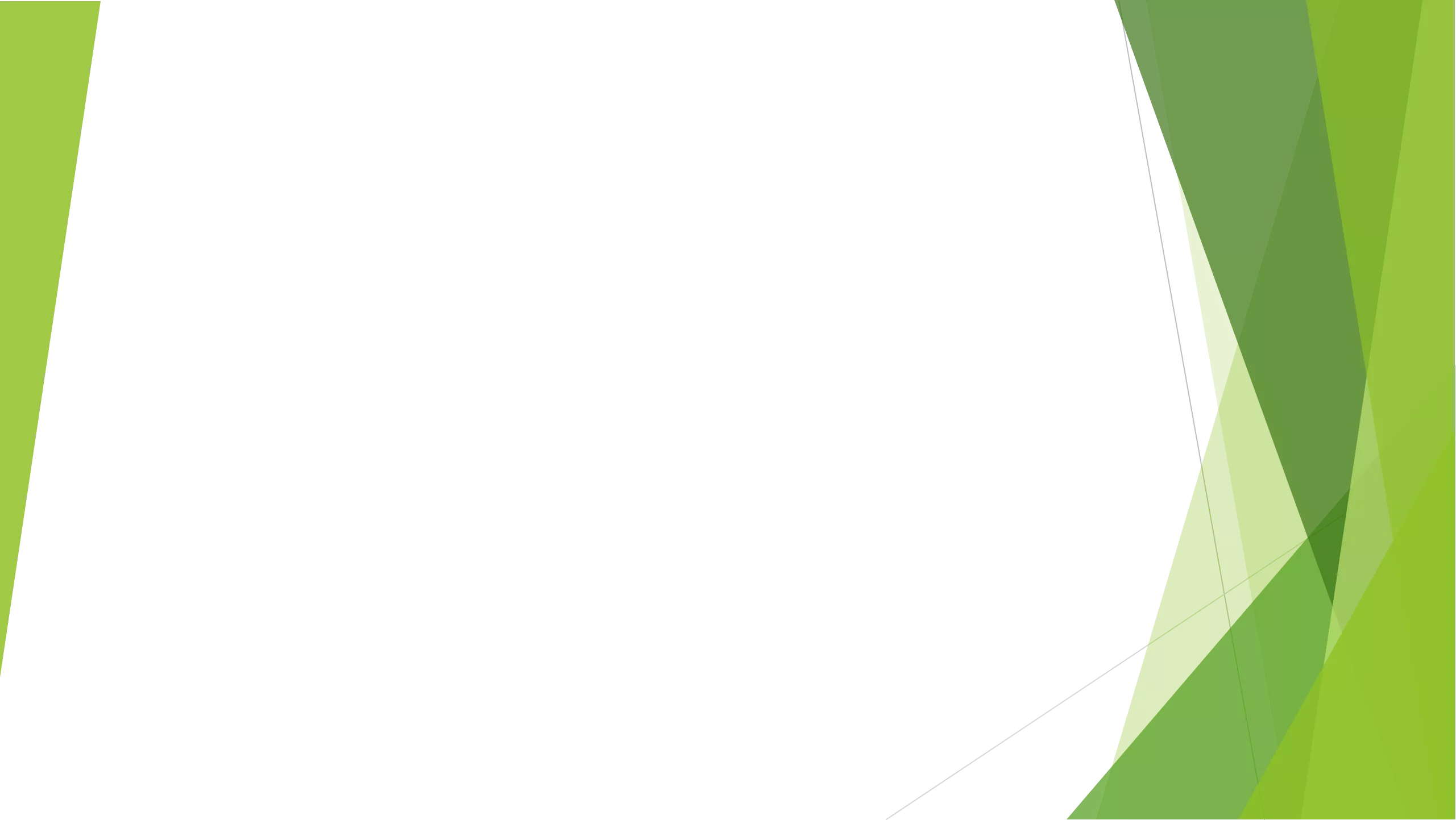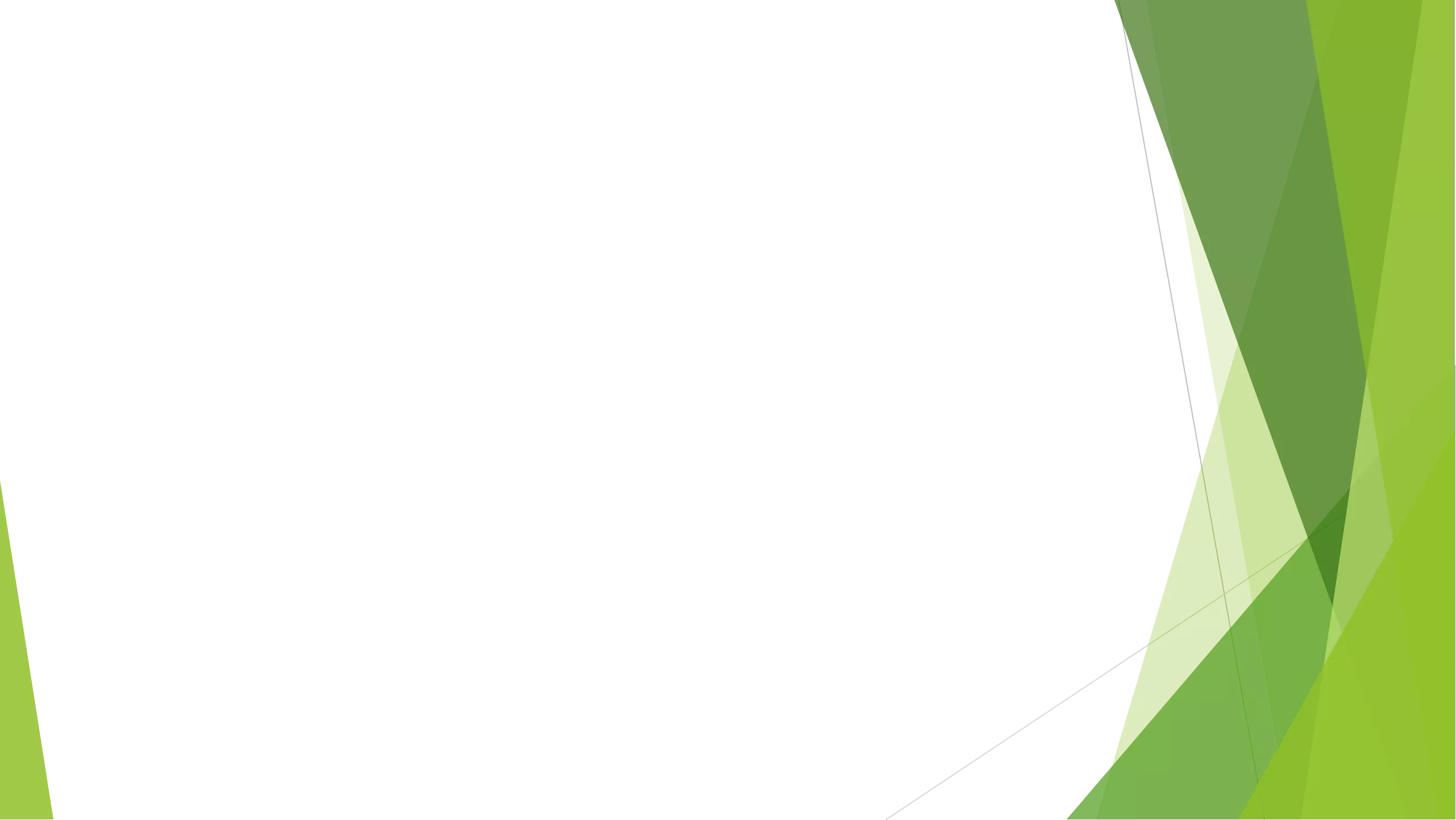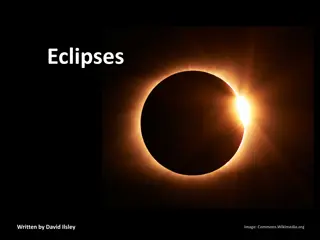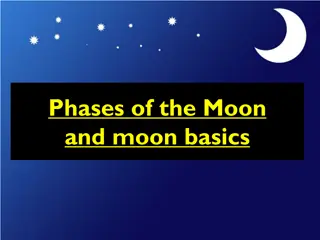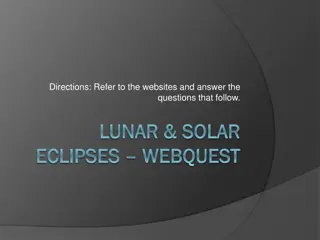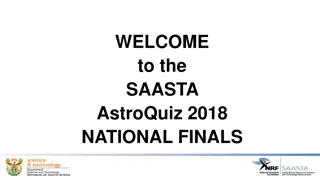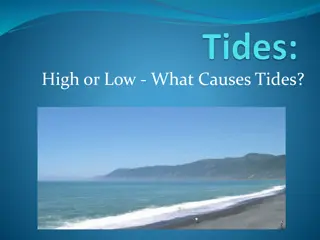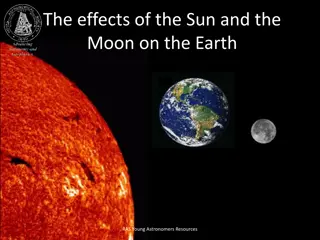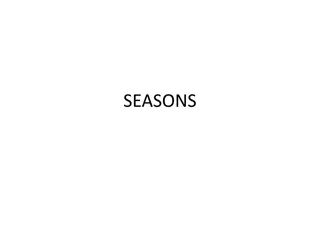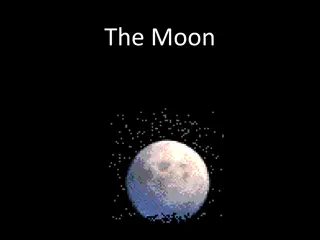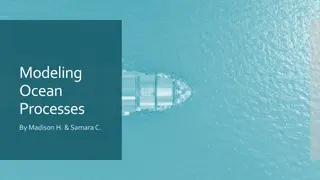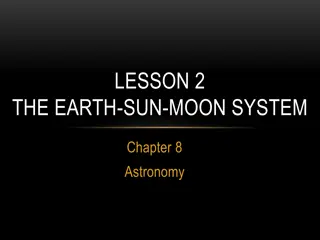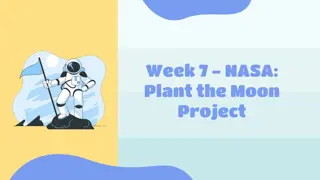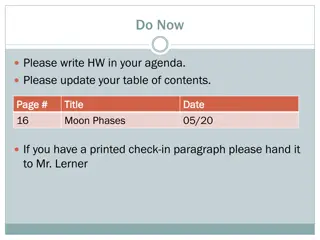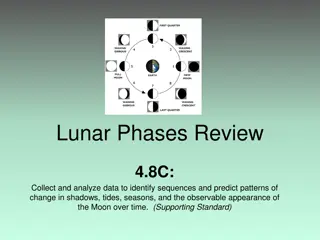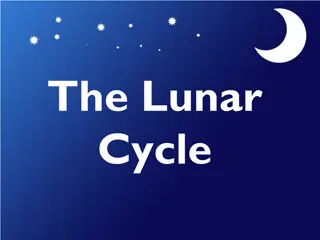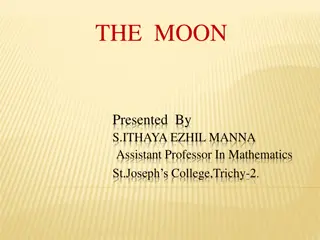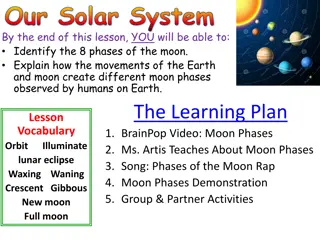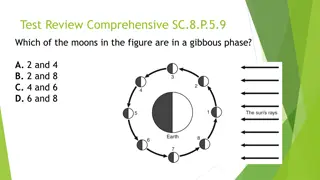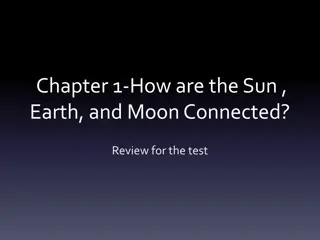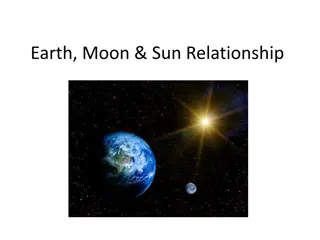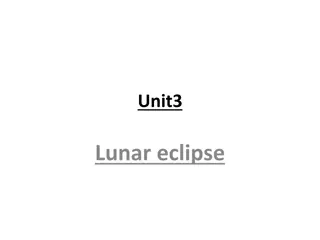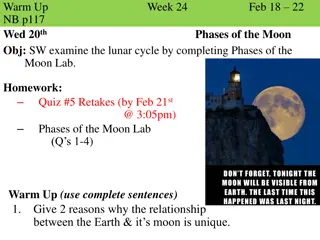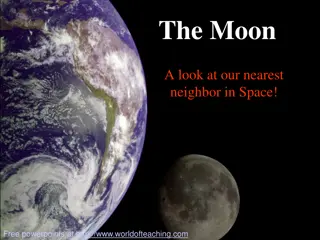The Phases of the Moon and Their Impact on Earth
This content delves into the phases of the moon and its influence on Earth, explaining the causes of each phase and detailing the interactions between the Moon, Earth, and Sun. Resources such as images, videos, and a game plan are provided to enhance understanding, along with a question related to identifying specific moon phases. Explore the content to grasp the relationship between celestial objects and the different lunar phases.
Download Presentation

Please find below an Image/Link to download the presentation.
The content on the website is provided AS IS for your information and personal use only. It may not be sold, licensed, or shared on other websites without obtaining consent from the author. Download presentation by click this link. If you encounter any issues during the download, it is possible that the publisher has removed the file from their server.
E N D
Presentation Transcript
The Phases of the Moon SC.8.E.5.9: Explain the impact of objects in space on each other, including: 2. The Moon on Earth, including phases
Game Plan Phases of the Moon Today I will look for key details about the phases of the moon. So that I can (1) provide evidence for each phase of the moon and causes (2) Recognize and be able to draw each phase of a lunar eclipse. I know I have it when I completed my 8 tab foldable with details and drawing of each lunar eclipse. (2) Label each lunar phase correctly. When I can answer my post question with 100 percent accuracy.
8 Door Foldable Page 212 and 213 Inside the tabs place the drawing of the phase and details way through the cycle the full light is on the moon. Earth in the middle More than lit but Full Moon Waxing Gibbous not fully lit, growing More than lit but 1 Quarter of the cycle First Quarter has occurred Waning Gibbous not fully lit, light decreases Drawing Detail Waxing crescent Thin crescent shape, it waxes or grow Third Quarter 3rd quarter in the cycle Going into a thin Earth, moon and sun line up which the near New Moon side can t be seen Waning Crescent crescent shape During the full week
Videos for Phases of the Moon Rapping Song of the Moon https://www.youtube.com/watch?v=79M2lSVZiY4 Pop Up Phases https://www.youtube.com/watch?v=KV- BPLKjQB4&list=PL5hz5YGdWwi1cbb4vIZ0U32w3k1jJCYKt&index=5 Cycle of the Moon https://www.youtube.com/watch?v=KV- BPLKjQB4&list=PL5hz5YGdWwi1cbb4vIZ0U32w3k1jJCYKt&index=5
Phases of the moon Third Quarter Waning Crescent Waning Gibbous Full moon New Moon 1st Quarter Waxing Gibbous Waxing Crescent
Which phases occur at points 1 and 5, and what is causing the phases? A. The new moon at point 1 and the full moon at point 5 are phases caused because the Moon changes its shape from night to night. B. The new moon at point 1 and the full moon at point 5 are phases when the Moon looks like it is changing shape as Earth goes around the Moon. C. The full moon at point 1 and the new moon at point 5 are phases caused because half of the Moon is always lit by the Sun, but only part of the Moon s lit surface can be seen as the Moon orbits Earth and Earth orbits the Sun. D. The new moon at point 1 and the full moon at point 5 are phases caused because half of the Moon is always lit by the Sun, but only part of the Moon s lit surface can be seen as the Moon orbits Earth and Earth orbits the Sun.
The cycle of the moons phases repeats in a predictable way. About how long does it take to cycle from one new moon to the next new moon? A. about one day B. about one week C. about one month D. about one year
The phases of the moon are the changing appearances of the moon, as seen from Earth. Which phase happens immediately after a third quarter moon? A. new moon B. waxing gibbous C. waning gibbous D. waning crescent
The phases of the moon are caused by the relative positions of Earth, the sun, and the moon. Lunar phases refer to the appearance of the illuminated portion of the moon as seen by an observer on Earth. When the moon is aligned with and between Earth and the sun, which phase is happening? A. full moon B. new moon C. first quarter moon D. third quarter moon
Sometimes the moon looks like a crescent. At other times, the moon looks like a half circle. What makes it possible for you to see the surface of the moon from Earth? A. The moon gives off its own light. B. Light from the sun is reflected by the moon s surface. C. Light from Earth is reflected by the moon s surface. D. The moon absorbs sunlight during the day and glows at night.
Just as Earth moves around the sun, the moon revolves around Earth. About how many Earth days does it take for the moon to travel around Earth? A. about 7 days B. about 28 days C. about 180 days D. about 365 days
Although half of the moon is always illuminated, usually only a portion of the illuminated side is visible from Earth. The diagram below presents the relative positions of Earth, the sun, and the moon. The positions of the moon are labeled 1 8. Which of the moons in the figure are in a crescent phase? A. 2 and 4 B. 2 and 8 C. 4 and 6 D. 6 and 8
Eclipses SC.8.E.5.9: Explain the impact of eclipses
Game Plan Eclipses Today I will cite specific evidence from a video about lunar eclipses and solar eclipses. So that I can (1) Explain each type of eclipse. (2) Explain the different types of shadows. (3) Draw lunar and solar eclipses. I know I have it when I have completed my Cornell notes by answering all 7 questions correctly. I have illustrated the eclipses. When I can answer my exit question with 100 percent accuracy.
Cornell Notes Eclipses What causes an eclipse? Questions 1. What s an eclipse? Name Date Period Page 5 Notes Either the moon or the sun is going to be blocked for a period of time. When the moon is in the middle and blocks our view from the sun 2. Solar eclipse- Earth is between the sun and moon and blocks the moon 3. Lunar eclipse- 4. Why can t we see many lunar and solar eclipse in a year? 5. What lunar phase is the moon in to receive an eclipse? 6. What are different types of lunar eclipses 7. What does path of totality mean? The tilt of the orbit isn t aligned to receive the shadow on it. Full moon is the phase to have a lunar eclipse) Penumbral =moon is dim/ Parital = umbra and penumbra (looks like a bite happened/ total eclipse The umbra covers small strip of land at the shadow passes
Occasionally, one space object travels through the shadow of another space object. When the moon moves between the sun and Earth casting a shadow on Earth, which solar system event is taking place? A. a full moon B. a crescent moon C. a solar eclipse D. a lunar eclipse
Space bodies, such as Earth and its moon, are not stationary. Rather, they are moving at a rapid speed. The diagrams below show the relative movements of the sun (S), Earth (E), and the moon (M). Which diagram best represents the motion of Earth and the moon, relative to the sun? A B C D
Which statement best explains the motions and positions of the Sun, Moon, and Earth? A. The force of the Sun s gravity holds Earth and the Moon in close but separate orbits as they both revolve around the Sun together. B. The force of the Moon s gravity pulling on the Sun holds it in orbit around the Sun, and the force of Earth s gravity pulling on the Moon holds the planet in orbit around the Sun. C. The force of Earth s gravity holds the Moon in orbit around Earth, and the force of the Sun s gravity holds Earth in orbit around the Sun, so that Earth with its orbiting Moon go around the Sun together. D. The force of the Sun s gravity holds the Moon in orbit around Earth, and the force of the Sun s gravity also holds Earth in orbit around the Sun, so that Earth with its orbiting Moon appear to go around the Sun together.
Which statement best describes the event caused by the way in which the three bodies are lined up? A total lunar eclipse that occurs only in the place where the Moon s shadow (Y) falls on Earth. A. B. A total solar eclipse that occurs only in the place where the Moon s shadow (Y) falls on Earth. C. A phase called a new moon that occurs because the Moon is directly between Earth and the Sun. D. A total solar eclipse that occurs all over the world because the Moon s shadow (Y) falls on Earth.
Which part of the diagram is labeled Y? A. the umbra B. the eclipse C. the satellite D. the penumbra
Which solar system event is happening? A. a third quarter moon B. a lunar eclipse C. a first quarter moon D. a solar eclipse
The diagram below shows the relative positions of Earth, the sun, and the moon. Which part of the diagram is labeled X? A. the umbra B. the eclipse C. the satellite D. the penumbra
The diagram below shows the relative positions of the sun, the moon, and Earth. Which solar system event does the diagram show? A. a solar eclipse B. a lunar eclipse C. a first quarter moon D. a third quarter moon
Each lunar cycle has one full moon, in which the relative positions of Earth, the sun, and the moon form in a straight line. Which list represents the position of Earth, the sun, and the moon during a full moon? A. Earth, sun, moon B. sun, moon, Earth C. moon, sun, Earth D. sun, Earth, moon
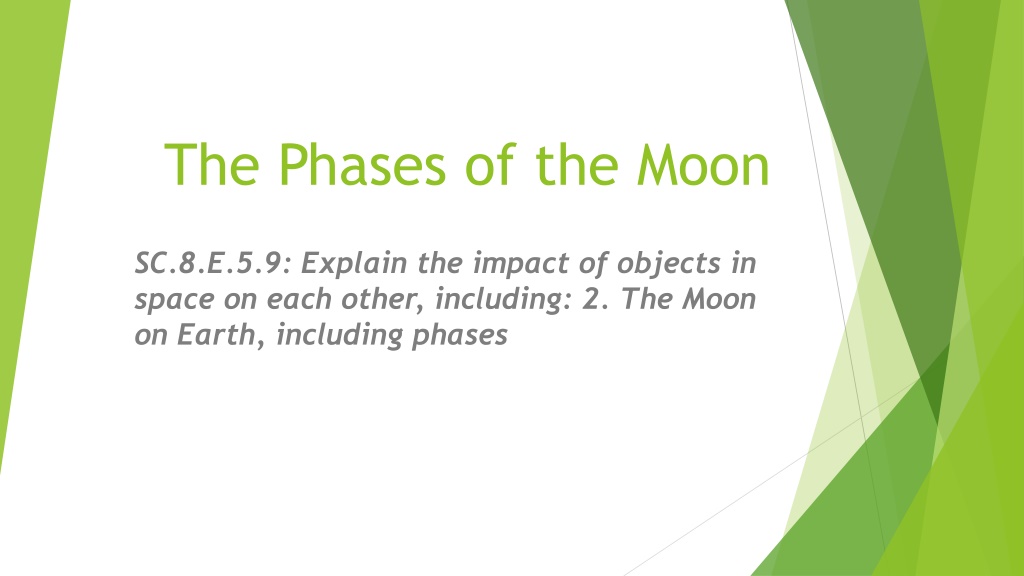
 undefined
undefined